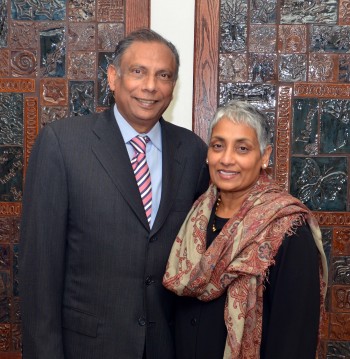
Most businessmen would be content with building a profitable company. Raj Vattikuti is not most men. He’s founded three successful companies—Covansys, Synova, and, most currently, Altimetrik, a global software company focusing on enterprise applications, mobile applications, and cloud enablement—and also established, along with his wife Padma, the Vattikuti Foundation, an international charitable organization tackling issues as ambitious as curing cancer and global poverty.
Vattikuti’s entrepreneurial vision is matched only by his tangible passion for helping others. His incredible dedication to both his professional and personal endeavors, and their resulting successes, is nothing short of inspiring. “My wife, Padma, and I have always had a passion for giving back,” Vattikuti says. “And the United States is such a philanthropic country that I am inspired to make an impact with our foundation, as well.”
The Vattikuti Foundation’s first initiative was supporting cancer research and treatment programs. This included donations to Henry Ford Hospitals, where the Vattikuti Urology Institute was established, and Beaumont Hospitals, home to the Vattikuti Digital Breast Diagnostic Center, both located in Michigan. More recently, the Vattikuti Foundation made a donation to Providence Hospital in Southfield, Michigan, to establish the Providence-Vattikuti Women’s Robotic Surgery Institute. “I find that focused giving suits me best, as it can be difficult to make a true impact if you are supporting too many causes,” Vattikuti says. “Our main focus areas for our charitable cancer initiatives are robotic surgery and digital mammography, both technologies making a significant impact on the detection and treatment of cancer.”
The health centers at Providence, Henry Ford, and Beaumont, along with six centers in India and one in Belgium, make up the Vattikuti Institute. The collective group is dedicated to state-of-the-art robotic surgery and innovation through collaboration and the promotion of advancements in research and training. “Robotic urologic surgeons around the world use techniques and procedures pioneered and perfected at the Vattikuti Urology Institute at Henry Ford,” Vattikuti says. “Our mission is to make robotic surgery available to the common man, because we believe it is the future of cancer surgery.”
Raj and Padma also seek to impact the future of the population of rural India, their native home, through an elaborate, wide-reaching initiative designed to alleviate poverty by increasing quality-of-life standards. Launched in 2009, the Poverty Alleviation Initiative (PAI) focuses on working through village community centers in India to provide employment, education, and health-care services with the aid of state-of-the-art technology. “Millions of people in rural India live in extreme poverty,” Vattikuti says. “This initiative is directed at aiding people in becoming self-sustainable, getting them on their feet. To me, that is the most effective form of giving.”
Number Crunching
The Poverty Alleviation Initiative
In 2009, the Vattikuti Foundation launched an ambition plan to provide employment, education, and health-care services to Indians in need. A look at the initiative, by the numbers:
20
Community centers opened during the initial launch
100
Villages impacted during the initial launch, covering an effective population of 120,000
180,000
Community centers necessary to make an impact throughout India
200m.
Indians that live in rural areas, in poverty, that the program hopes to reach
The PAI pilot program launched in 20 Gram Panchayats, with each Gram Panchayat consisting of five villages, to cover a population of approximately 120,000. With a goal of having all residents within each village self-sustaining within 18 months, it is truly an ambitious undertaking. “The program encompasses education for children, low-interest loans for business ventures, trade training for adults, and health-care education for families,” Vattikuti says. “Our goal is to lift families out of poverty to the middle class and, ideally, to have one child from each family attend college.
Much of PAI’s success is based on the Vattikuti Foundation’s investment in technology resources for effective data collection. For example, the program uses advanced mobile technology to collect demographic data and progressively monitor each family in the program for the purpose of analysis, evaluation, and future planning. “Technology is a necessary tool for advancing social and economic development, because it provides transparency, as well as easier and improved access to services,” Vattikuti says. “We employ a structured approach towards technology by using methods such as telemedicine, tele-education, and kiosk banking.”
Padma and Raj’s goal is to expand the program throughout 2013, launching 100 community centers at a time, then thousands at a time, to eventually cover more than 100 million people in rural India. By creating a “scalable model” approach to poverty, Vattikuti envisions other poverty-ridden countries in Africa and South America using the community-center approach to impact the lives of millions around the globe. “We realize this project is long-term—it will go on for many years, probably for my lifetime,” Vattikuti says. “But we have seen the successes it can generate, and we are constantly refining the model to make it more efficient and effective. The possibilities for impact are tremendous.”

